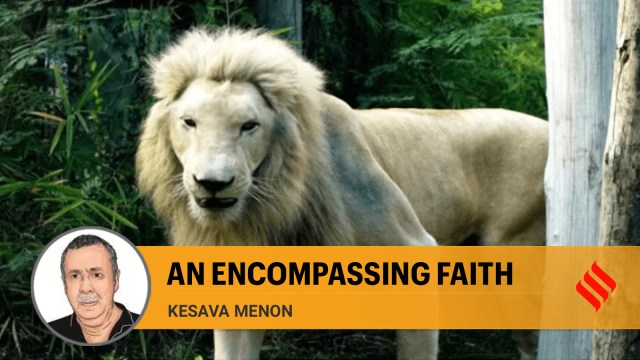
Will the Dashavathara now become the Sashtavathara? According to a litigant in the Calcutta High Court, the associating of Hindu gods with animals is blasphemy. If this argument is accepted, Matsya, Kurma, Varaha and Narasimha are illicit? From where does the concept of blasphemy come into Hinduism?
Those who petitioned the Court to direct the West Bengal government to change a captive lioness’s name from Sita to something else might argue that their objection is to the appellation of Janaki’s name to an animal. Don’t they know that this very name — as also Lakshmi and Nandini — have been given to cows since time immemorial? These appellations were always bestowed with the utmost reverence on the creatures that were the most beloved in the farmsteads.
If the High Court upholds the petitioner’s argument, the precedent will play havoc with ceremonial practices throughout India. In Kerala, for instance, most elephants that participate in festive processions bear the names of Hindu gods. A number of them have huge fan followings and some continue to be legends years after their demise. What are the two Padmanabhans and the Kesavan of the Guruvayur Devaswom to be known as from now on – Temple Tuskers P1, P2 and K1?
Or, is the objection to Sita’s name being appended to a carnivore? For the moment, let us leave aside the fact that she was a Kshatriya and hence no one commits any wrong in ascribing to her such culinary habits. Did the petitioners forget that they are living in Bengal where the lion/lioness is so integral a part of the Durga puja iconography? Most tableaux installed in the pandals depict Durga impaling Mahishasura while her lion/lioness mauls the buffalo part of the demon’s torso. Lady and beast are one in the fight against evil. A mere glance at Nandi’s idol in Mysuru’s Chamundi Hill is enough to make anyone comprehend why Shiva chose this powerful animal as his comrade-in-arms.
When a basic tenet of Hinduism postulates the equality of all creation, how can anyone claim that it sanctions the extension of the caste system to the natural world — that some names are not for lesser beings? As the reverence for elephants, tigers, bulls, cobras and even Ganesha’s rats indicates, the animal kingdom is for us Hindus a reflection of the celestial realm. As are peepals, banyans, lotuses and tulasis.
Our religion does not consist solely of Vedantic profundities, or high yagnas or bali or the bawdier phases of harvest festivals. It encompasses all these and more. For well over five millennia, almost every shade and nuance of the human experience has been observed, analysed, weighed morally and woven into a bewilderingly rich symphony of aphorisms that can offer guidance but do not necessarily prescribe.
There are always shades and nuances. In our common understanding, Duryodhana is the villain of the Mahabharata. However, there are places where he is worshipped as Suyodhana. On first hearing, one wonders how that can be until one remembers his last speech delivered as he lay with a shattered groin. Then you cannot but admire his indomitable nature, his generosity towards friends and his refusal to let others judge him.
Or Jayadratha for that matter. In the popular imagination he sticks out for two actions, both of them reprehensible — the attempt to abduct Panchali and the shutting down of Abhimanyu’s support lines. However, I have come across Sindhi nationalists in Karachi who honour him as an epitome of their race’s virility.
Seldom do we come across one right or wrong. Our perspectives and judgements must be shaped by the weighing of multiple factors just as life itself is. We can revere Ganesha’s vahana but we will still trap and kill any rat that enters our kitchens. In this moral/spiritual universe, we need to see reality as clearly as we can and use our capacity to discriminate constantly. For that we need open minds, not an uncontrolled instinct to shut down whatever we think we cannot bear to hear.
The writer is former editor of Mathrubhumi